Shoulder Instability
Updated:
(Also known as Anterior Instability, Posterior Instability, Inferior Instability, Multidirectional Instability, Recurrent Subluxing Shoulder)
What is shoulder instability?
Shoulder instability is relatively common condition characterized by loosening of the connective tissue (ligaments and joint capsule) surrounding the shoulder joint therefore enabling the bones forming the joint to move excessively on each other.
The shoulder joint is a ball and socket joint. The shoulder blade gives rise to the socket of the shoulder, whilst the ball of the shoulder arises from the top of the humerus (upper arm bone). Surrounding the ball and socket joint is strong connective tissue holding the bones together known as the shoulder joint capsule (figure 1) and its associated ligaments (the glenohumeral ligaments). In addition, a group of muscles known as the rotator cuff cross the shoulder joint and actively help to hold the shoulder joint in position increasing the shoulder’s stability.
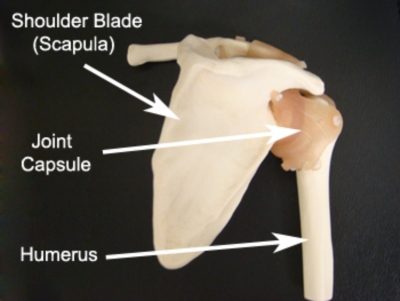
During certain movements of the arm (such as throwing or falling on an outstretched arm), stretching forces are applied to the shoulder joint capsule and ligaments. When these forces are traumatic or repetitive enough, stretching or tearing of the connective tissue may occur. As a result, the connective tissue supporting the shoulder may become loose and unsupportive, allowing the joint to move excessively and resulting in an “unstable” joint. This condition is known as shoulder instability and may result in the upper arm bone (humerus) moving partially or completely out of the socket during certain arm movements (subluxation or dislocation). Shoulder instability normally presents in one shoulder. Occasionally, however, it may exist in both shoulders, particularly in those patients who have general ligament laxity (i.e. loose connective tissue), or in those patients who perform repetitive overhead activities on both sides of the body (such as swimmers).
Causes of shoulder instability
Shoulder instability most commonly occurs following a traumatic incident that partially or completely dislocates the shoulder (such as a fall onto the shoulder, or outstretched hand, or, following a direct blow to the shoulder). This frequently occurs in contact sports such as rugby or Australian rules football, high velocity sports, such as downhill skiing, snowboarding, skateboarding, or in competitive overhead sports such as basketball or water polo. The usual movements involved are a combination of shoulder abduction (side elevation) and excessive external rotation (outer rotation of the humerus) (figure 2) combined with a force to the back of the shoulder or front of the elbow (or both).
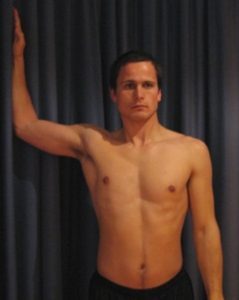
Shoulder Instability may also occur gradually over time (atraumatically) due to repeated stresses to the shoulder joint associated with repetitive end of range shoulder movements (such as throwing or swimming). This may occur in association with abnormal biomechanics such as poor throwing technique or a faulty swimming stroke and commonly occurs in sports requiring repeated overhead activities such as baseball pitchers, javelin throwers, cricketers, swimmers and tennis players.
Occasionally, shoulder instability may be associated with generalized ligamentous laxity throughout the body. This may be something that is present from birth and is commonly referred to as being ‘double jointed’.
Signs and symptoms of shoulder instability
Patients with shoulder instability may experience little or no symptoms. In atraumatic shoulder instability, the first sign of symptoms may be an episode of the shoulder subluxing (i.e. partially dislocating). In other cases, patients may initially experience shoulder pain or an ache either during, or following, certain activities.
In post-traumatic shoulder instability the patient usually reports a specific painful incident that caused the problem. Commonly the shoulder will have dislocated or subluxed, often with the arm in a position of combined abduction and external rotation at the time of injury (figure 2). Following this incident, the patient may experience pain during certain activities or after these activities with rest (especially at night or the next morning). The patient often reports that the shoulder has never felt the same since.
Patients with shoulder instability will often notice a clicking, clunking or popping sensation within the shoulder during certain movements. There may be a loss of power in the affected shoulder and a feeling of weakness during certain activities (e.g. overhead activity). Patients may also experience tenderness upon firmly touching the front or the back of the shoulder joint and a feeling of apprehension that the shoulder may dislocate with certain end of range movements (particularly the combination of abduction and external rotation) (figure 2). Patients may also experience pain or a sensation of the shoulder joint moving out of place during certain movements or when sleeping on the affected side.
In severe cases of shoulder instability, patients frequently experience recurrent episodes of subluxation or dislocation of the shoulder. This may be associated with shoulder pain and occasionally, a ‘dead arm’ sensation which typically resolves after a few minutes rest. In these instances or in patients with multidirectional instability, the patient may be able to voluntarily sublux or dislocate the shoulder. In more severe cases, relatively minor activities such as yawning or rolling over in bed may result in a subluxation or dislocation.
Diagnosis of shoulder instability
A thorough subjective and objective examination from a physiotherapist is usually sufficient to diagnose shoulder instability. Further investigations such as an X-ray, CT scan, Ultrasound or MRI may be required to assist diagnosis and determine involvement of other structures (such as labral tears, rotator cuff tendinopathy or fractures).
Treatment for shoulder instability

Members Only ContentBecome a PhysioAdvisor Member to gain full access to this exclusive content. For more details see Become a Member. Already a member? Login Now
Prognosis of shoulder instability
Many patients with shoulder instability heal well with an appropriate rehabilitation program and physiotherapy treatment. This may take weeks to months to achieve an optimal outcome. In cases of recurrent shoulder subluxation or dislocation that is unresponsive to conservative treatment, surgical repair of the shoulder joint capsule may be indicated to stabilize the shoulder. This is usually followed by an extensive rehabilitation program lasting many months.
Patients who also have damage to other structures such as cartilage, bone, tendons or nerves are likely to have a significantly extended rehabilitation period to gain optimum function.
Contributing factors to the development of shoulder instability
There are several factors that can contribute to the development of shoulder instability and associated symptoms. These need to be assessed and, where possible, corrected with direction from a physiotherapist. Some of these factors may include:
- history of previous shoulder subluxation or dislocation
- inadequate rehabilitation following a shoulder dislocation
- intensive participation in sports or activities placing the shoulder at risk of developing instability
- muscle weakness (particularly of the scapular stabilizers and rotator cuff)
- muscle imbalances
- poor posture
- shoulder joint hypermobility
- general ligamentous laxity
- abnormal biomechanics or sporting technique (such as poor throwing technique or faulty swimming style)
- thoracic spine stiffness
- muscle tightness (affecting posture)
- poor core stability
- inappropriate training or technique
- change in training conditions
- poor posture
- fatigue
- inadequate warm up
Physiotherapy for shoulder instability
Physiotherapy treatment for shoulder instability is vital to hasten the healing process and ensure an optimal outcome. Treatment may comprise:
- anti-inflammatory advice
- soft tissue massage
- protective shoulder taping
- short term use of a sling for pain relief
- joint mobilization (thoracic spine or neck)
- dry needling
- ice or heat treatment
- electrotherapy (e.g. ultrasound)
- education
- progressive exercises to improve rotator cuff strength, shoulder blade stability, shoulder strength, posture and core stability
- postural correction
- activity modification advice
- biomechanical correction (e.g. correction of throwing technique, swimming stroke, tennis serve, weight lifting technique etc.)
- clinical Pilates
- devising and monitoring a return to sport or activity plan
Other intervention for shoulder instability
Despite appropriate physiotherapy management, some patients with shoulder instability require other intervention to ensure an optimal outcome. The treating physiotherapist or doctor can advise on the best course of management when this is the case. This may include further investigations such as X-rays, ultrasound, CT scan or MRI, pharmaceutical intervention, corticosteroid injection, or referral to appropriate medical authorities who can advise on any intervention that may be appropriate to improve the condition. Occasionally, patients may require surgery to repair the loose or torn connective tissue that holds the shoulder in place or to correct other abnormalities associated with the shoulder instability (such as a labral tear or a rotator cuff tear).
Exercises for shoulder instability
The following exercises are commonly prescribed to patients with shoulder instability. You should discuss the suitability of these exercises with your physiotherapist prior to beginning them. Generally, they should be performed 3 times daily and only provided they do not cause or increase symptoms.
Your physiotherapist can advise when it is appropriate to begin the initial exercises and eventually progress to the intermediate and advanced exercises. As a general rule, addition of exercises or progression to more advanced exercises should take place provided there is no increase in symptoms.
Initial Exercises
Shoulder Blade Squeezes
Begin this exercise standing or sitting with your back straight (figure 3). Your chin should be tucked in slightly and your shoulders should be back slightly. Slowly squeeze your shoulder blades together as hard and far as possible provided it does not cause or increase symptoms. Hold for 5 seconds and repeat 10 times provided the exercise is pain free.

Static Rotator Cuff Contraction
Begin this exercise standing with your back and neck straight and your shoulders back slightly. Keeping your elbow at your side and bent to 90 degrees, push your hand out against the other hands resistance as hard as possible provided it is pain free (figure 4). Hold for 10 seconds and repeat 5 – 10 times on each arm provided there is no increase in symptoms.
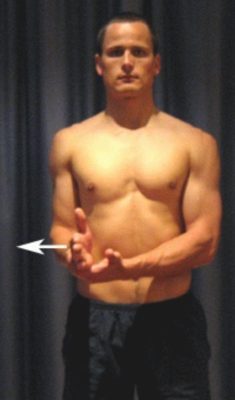
Shoulder Blade Shrug
Begin this exercise standing with your back and neck straight. Your arm should be at your side, slightly away from your body with your palm facing forwards as demonstrated (figure 5). Slowly elevate your shoulder blade towards your ear as far as possible provided the exercise is pain free (figure 5). Hold for 5 seconds, then slowly return to the starting position and repeat 10 times provided the exercise does not cause or increase symptoms.
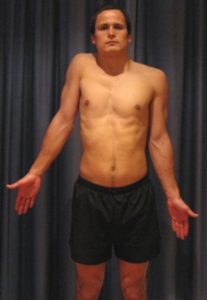
Intermediate Exercises

Members Only ContentBecome a PhysioAdvisor Member to gain full access to this exclusive content. For more details see Become a Member. Already a member? Login Now
Advanced Exercises

Members Only ContentBecome a PhysioAdvisor Member to gain full access to this exclusive content. For more details see Become a Member. Already a member? Login Now
Other Exercises

Members Only ContentBecome a PhysioAdvisor Member to gain full access to this exclusive content. For more details see Become a Member. Already a member? Login Now
Rehabilitation Protocol for Shoulder Instability

Members Only ContentBecome a PhysioAdvisor Member to gain full access to this exclusive content. For more details see Become a Member. Already a member? Login Now
 Find a Physio for shoulder instability
Find a Physio for shoulder instability
Find a physiotherapist in your local area who can treat shoulder instability.
 Physiotherapy products for shoulder instability
Physiotherapy products for shoulder instability
Some of the most commonly recommended products by physiotherapists to hasten healing and speed recovery in patients with shoulder instability include:
-
 OPPO – Posture Aid / Clavicle Brace (OPP2075)
OPPO – Posture Aid / Clavicle Brace (OPP2075) -
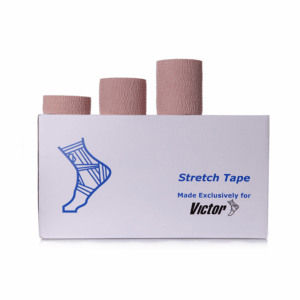 Elastic Adhesive Bandage (Sportstek Victor Stretch Tape)
Elastic Adhesive Bandage (Sportstek Victor Stretch Tape) -
 AllCare Band
AllCare Band -
 Oppo Humerus Brace (OPP4072)
Oppo Humerus Brace (OPP4072) -
 Premium Strapping Tape 38mm (Victor)
Premium Strapping Tape 38mm (Victor) -
 AllCare Pro-TENS Machine
AllCare Pro-TENS Machine -
 AllCare Tubing
AllCare Tubing -
 AllCare Spikey Massage Ball
AllCare Spikey Massage Ball -
 Fixomull Stretch 5cm x 10m
Fixomull Stretch 5cm x 10m -
 AllCare Instant Cold Pack (15 x 25cm)
AllCare Instant Cold Pack (15 x 25cm) -
 Actimove Arm Sling (Mitella)
Actimove Arm Sling (Mitella)
To purchase physiotherapy products for shoulder instability click on one of the above links or visit the PhysioAdvisor Shop.
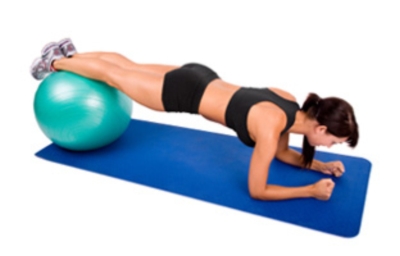 More Exercises
More Exercises
- Shoulder Strengthening Exercises.
- Scapula Stability Exercises.
- Rotator Cuff Strengthening Exercises.
- Upper Body Machine Weights.
- Cable Exercises (Chest & Shoulders).
- Cable Exercises (Back & Biceps).
- Free Weights (Chest & Shoulders).
- Free Weights (Back & Biceps).
- Shoulder Stretches.
- Arm Strengthening Exercises.
- Cardiovascular Exercise.
 More Information
More Information
- Read about Shoulder Taping.
- Read about Postural Taping.
- Read about improving your Posture.
- View detailed information on when to use Ice or Heat.
- View detailed information on initial injury management and the R.I.C.E. Regime.
- View detailed information on Returning to Sport.
- View detailed information on Injury Prevention.
- View our Shoulder Diagnosis Guide.
Become a PhysioAdvisor Member

Link to this Page
If you would like to link to this article on your website, simply copy the code below and add it to your page:
<a href="https://physioadvisor.com.au/injuries/shoulder/shoulder-instability”>Shoulder Instability – PhysioAdvisor.com</a><br/>PhysioAdvisor offers detailed physiotherapy information on shoulder instability including: causes, symptoms, diagnosis, treatment, exercises, rehabilitation protocol, prognosis, physiotherapy products and more...
Return to the top of Shoulder Instability.


